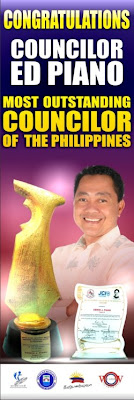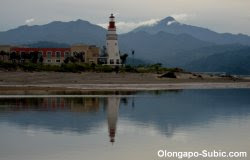US & PHIL GOVT SUED OVER CLARK/SUBIC
This is the story of a people’s quest for justice against a superpower which once ruled their lives as a colonial sovereign and used their territory to advance the superpower’s military supremacy in Asia and in the world.
This is also the tale of their fight for justice against their own government which, by the manner it tolerated the superpower’s abusive deeds in the use of their territory, almost permitted the commission of such abusive acts.
In particular, this is the story of the plaintiffs as human victims of toxic waste contamination in the former Clark Air Base and Subic Naval Base.
But in general, this is also the story of the Filipino people, both present and future generations, whose environment, heavily damaged by the United States of America after almost a century of occupation and use, is the bigger victim. The damage to the environment in Clark and Subic will ever remain present, even for many long years to come, unless cleaned up, the cost of which has been estimated to reach “superfund” proportions reaching billions of U.S. dollars.
Essentially therefore, this is the Filipino people’s quest for justice for their environment, against the United States, undoubtedly a superpower, who occupied and used Clark and Subic for almost a century, as a colonial sovereign for the first 48 years and as a privileged tenant for the next 46 years.
A privileged tenant because it drafted by itself the terms and conditions of the 1947 Military Bases Agreement (MBA) and merely required the 8-month old Philippine government to sign and accept said agreement in March 1946.
A privileged tenant indeed because, strictly speaking under the 1947 MBA as amended, the US was not even required to pay any rental obligations to the Philippines for its occupation and use of Clark and Subic.
But more than all this, it was privileged because its landlord, the Philippine government, by gross negligence or sheer cowardice, did not assert its right and duty under the Constitution and pertinent laws to protect and preserve its environment and people from harm and degradation.
The people’s quest for justice began when, shortly after the US Air Force withdrew from Clark in November 1991, around 20,000 Filipino families rendered homeless by Mt. Pinatubo eruption were relocated by the Philippine government in Cabcom (Clark Air Base Command), a portion inside the former air base designated by the Philippine government as temporary evacuation center for all Mt. Pinatubo victims.
While these Mt. Pinatubo victims were in Cabcom, they were given and permitted by the Philippine government to install more than 200 pump wells. From these pump wells, the victims drew their daily water needs for drinking, cooking, milkmixing, bathing, laundry and other similar needs.
Initially, they complained of the odd odor, color and taste of the water drawn. Soon members of their families complained of severe stomach pains, irregular bowel movements, headaches, dizziness and other minor health complaints.
Later however, some of them acquired various skin disorders, while others had grown large cysts or masses in various body parts. Pregnant women suffered spontaneous abortions, still births, fetal deaths and birth defects or congenital deformities. Deaths due to leukemia, heart ailment, kidney disorder, lung problem, among others, began to surface in alarming numbers.
These deaths and illnesses brought to the fore the issue of toxic waste contamination not only in Clark Air Base but also in Subic Naval Base. As these deaths and illnesses got reported in national and international news, several studies and investigations were conducted in the areas by different groups.
All these studies and investigations were uniform in their discovery – that there are toxic chemicals and hazardous wastes found in both Clark and Subic. Some of these studies even identified certain specific areas as positively contaminated. Others vary only in their findings on the levels or degrees of toxins present.
Hence, whether or not there are toxins or contaminants in Clark and Subic is no longer an issue. The question only is the extent of the contamination, or put another way, the extent of the environmental damage.
But the much bigger question to ask is -– Did the U.S. Navy and Air Force have knowledge of the toxic waste contamination?
This is also the tale of their fight for justice against their own government which, by the manner it tolerated the superpower’s abusive deeds in the use of their territory, almost permitted the commission of such abusive acts.
In particular, this is the story of the plaintiffs as human victims of toxic waste contamination in the former Clark Air Base and Subic Naval Base.
But in general, this is also the story of the Filipino people, both present and future generations, whose environment, heavily damaged by the United States of America after almost a century of occupation and use, is the bigger victim. The damage to the environment in Clark and Subic will ever remain present, even for many long years to come, unless cleaned up, the cost of which has been estimated to reach “superfund” proportions reaching billions of U.S. dollars.
Essentially therefore, this is the Filipino people’s quest for justice for their environment, against the United States, undoubtedly a superpower, who occupied and used Clark and Subic for almost a century, as a colonial sovereign for the first 48 years and as a privileged tenant for the next 46 years.
A privileged tenant because it drafted by itself the terms and conditions of the 1947 Military Bases Agreement (MBA) and merely required the 8-month old Philippine government to sign and accept said agreement in March 1946.
A privileged tenant indeed because, strictly speaking under the 1947 MBA as amended, the US was not even required to pay any rental obligations to the Philippines for its occupation and use of Clark and Subic.
But more than all this, it was privileged because its landlord, the Philippine government, by gross negligence or sheer cowardice, did not assert its right and duty under the Constitution and pertinent laws to protect and preserve its environment and people from harm and degradation.
The people’s quest for justice began when, shortly after the US Air Force withdrew from Clark in November 1991, around 20,000 Filipino families rendered homeless by Mt. Pinatubo eruption were relocated by the Philippine government in Cabcom (Clark Air Base Command), a portion inside the former air base designated by the Philippine government as temporary evacuation center for all Mt. Pinatubo victims.
While these Mt. Pinatubo victims were in Cabcom, they were given and permitted by the Philippine government to install more than 200 pump wells. From these pump wells, the victims drew their daily water needs for drinking, cooking, milkmixing, bathing, laundry and other similar needs.
Initially, they complained of the odd odor, color and taste of the water drawn. Soon members of their families complained of severe stomach pains, irregular bowel movements, headaches, dizziness and other minor health complaints.
Later however, some of them acquired various skin disorders, while others had grown large cysts or masses in various body parts. Pregnant women suffered spontaneous abortions, still births, fetal deaths and birth defects or congenital deformities. Deaths due to leukemia, heart ailment, kidney disorder, lung problem, among others, began to surface in alarming numbers.
These deaths and illnesses brought to the fore the issue of toxic waste contamination not only in Clark Air Base but also in Subic Naval Base. As these deaths and illnesses got reported in national and international news, several studies and investigations were conducted in the areas by different groups.
All these studies and investigations were uniform in their discovery – that there are toxic chemicals and hazardous wastes found in both Clark and Subic. Some of these studies even identified certain specific areas as positively contaminated. Others vary only in their findings on the levels or degrees of toxins present.
Hence, whether or not there are toxins or contaminants in Clark and Subic is no longer an issue. The question only is the extent of the contamination, or put another way, the extent of the environmental damage.
But the much bigger question to ask is -– Did the U.S. Navy and Air Force have knowledge of the toxic waste contamination?






